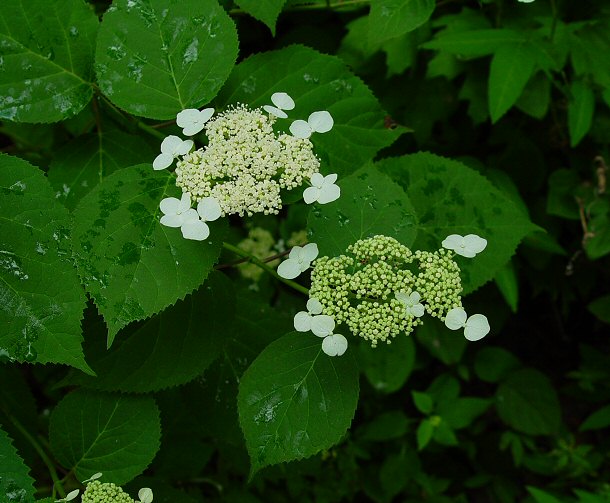Hydrangea arborescens L.
American Hydrangea

Native
CC = 7
CW = 3
MOC = 52
© DETenaglia
Hydrangea arborescens L.American Hydrangea | |
 |
Native CC = 7 CW = 3 MOC = 52 |
© DETenaglia |
|
Family - Hydrangeaceae Habit - Shrubs, often colonial by rhizomes or stems which contact the ground and root at the nodes. Stem - Arching or spreading to erect, to 2 m. Bark tan to grayish tan on older branches and peeling in long thin strips. Twigs light brown to brown, rarely reddish-tinged, sparsely to moderately hairy, the axillary buds small, with 3 or 4 scales visible, partially hidden by the U-shaped petiole bases.
Leaves - Opposite, simple, long petiolate. Blades 6-16 cm long, 3-12 cm wide, broadly ovate or elliptic-ovate, tapered to a sharply pointed tip, mostly rounded to shallowly cordate (less commonly narrowed) at the base, the margins relatively coarsely toothed, the upper surface darker green, glabrous or sparsely hairy along the main veins, the undersurface light green, sparsely to densely hairy, sometimes only along the veins.
Inflorescences - Terminal, much-branched, flat-topped to somewhat dome-shaped panicles, with at least some of the peripheral flowers sterile or staminate and showier than the fertile flowers.
Flowers - Calyces of the fertile flowers of usually 5 free sepals, these 0.3-0.6 mm long, triangular, glabrous, green; those of the sterile flowers of 3 or 4 sepals, these fused at the base, 6-12 mm long, broadly elliptic-ovate to angular-circular, glabrous, petaloid, white to greenish white. Corollas of 4 or 5 free petals, these 1.0-1.6 mm long, oblong-elliptic, white, sometimes absent on sterile flowers. Stamens 10. Pistils 2 carpels, these united to the tip. Ovary completely inferior, 2-locular. Styles 2, the stigmas capitate to club-shaped.
Fruits - Capsules 2.0-2.5 mm long, broadly obconic to nearly globose, the surface with 8 or 9 prominent longitudinal ribs, dehiscing by a terminal slit developing between the styles. Seeds 0.6-0.8 mm long, oblong ellipsoid, more or less tapered at each end, the surface with several longitudinal ribs, brown, shiny.
Flowering - May - June. Habitat - Forests, streambanks, shaded bluffs. Origin - Native to the U.S. Lookalikes - None. Other info. - This plant is found in the southeastern half of Missouri and throughout much of the eastern U.S. It is rare northwest of a diagonal line between the southwest corner of the state and the St. Louis region, and this line also partially demarcates the U.S. range. When in flower the plant is easy to recognize, with a few sterile but showy pseudo-flowers lending a characteristic appearance to the inflorescence. Plants bred for inflorescences consisting entirely of these sterile flowers are popular in landscaping and horticulture, known by names such as "snowball bush" or "bigleaf hydrangea." The large, showy petalloid sepals respond to soil pH by adjusting their color. Plants grown in acidic soils have blue inflorescences, whereas neutral or alkaline soils lead to pink inflorescences. The color-pH relationship is opposite to that of litmus. The color dependence is not a result of simple indicator chemistry but rather reflects the availability of free trivalent aluminum ions in the soil, which is greater at low (acidic) pH. Photographs taken near Stegal Mountain, Shannon County, MO., 6-21-03, and at Alley Spring, MO., 6-12-04 (DETenaglia); also at Weldon Spring Conservation Area, St. Charles County, MO, 6-23-2007, Fox Creek, St. Louis County, MO, 8-14-2010, Johnson's Shut-Ins State Park, Reynolds County, MO, 6-20-2011, and near Boles, Franklin County, MO, 6-16-2016 (SRTurner). |